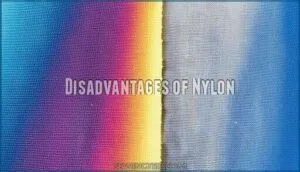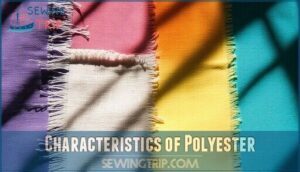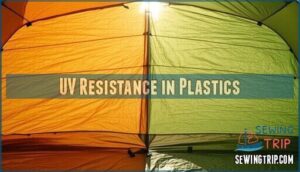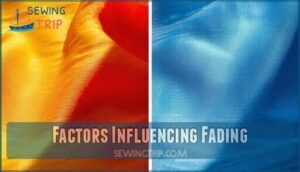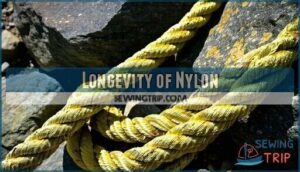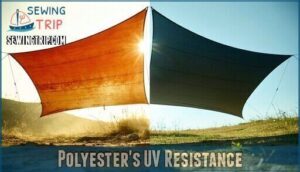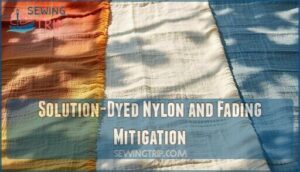This site is supported by our readers. We may earn a commission, at no cost to you, if you purchase through links.
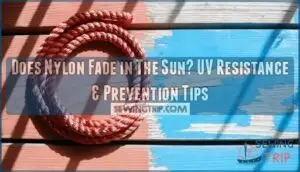 Yes, nylon does fade in the sun due to UV radiation breaking down its molecular structure and color compounds.
Yes, nylon does fade in the sun due to UV radiation breaking down its molecular structure and color compounds.
You’ll notice gradual color loss with prolonged exposure, especially in bright, direct sunlight.
While standard nylon isn’t naturally UV-resistant, some manufacturers create fade-resistant versions with special additives or treatments.
The fading process depends on factors like sun intensity, exposure duration, and the specific dye used, and darker colors typically fade more noticeably than lighter ones.
If you’re dealing with faded nylon items, there are restoration methods available, and understanding the science behind UV damage and knowing which protective strategies work best can help you keep your nylon items looking vibrant longer.
Table Of Contents
- Key Takeaways
- Nylon and Polyester Comparison
- Characteristics of Nylon
- Characteristics of Polyester
- UV Resistance in Plastics
- Factors Influencing Fading
- Longevity of Nylon
- Sunlight and Nylon Care
- Sunlight Effects on Polyester
- Material Selection and Product Longevity
- Expert Tips for UV-Resistant Choices
- Frequently Asked Questions (FAQs)
- Conclusion
Key Takeaways
- You’ll see nylon fade gradually in sunlight – UV radiation breaks down the molecular structure and dye compounds, causing visible color loss over time, especially with prolonged direct exposure.
- Darker colors show fading more noticeably than lighter ones – While all nylon colors fade, deep reds, blues, and blacks become more obviously washed out compared to pastels or earth tones.
- You can slow fading with protective measures – Store nylon items away from direct sun, apply UV protectant sprays every six months, and choose solution-dyed nylon when possible for better color retention.
- Polyester outperforms nylon for sun resistance – If you’re choosing between materials for outdoor use, polyester naturally resists UV damage better and maintains its color longer than standard nylon.
Nylon and Polyester Comparison
When comparing nylon and polyester for outdoor use, you’ll quickly notice a significant difference in how they handle sun exposure.
Polyester consistently outperforms nylon in UV resistance, making it the clear winner for preventing UV fading.
While nylon offers excellent durability and wear resistance, it lacks the natural UV damage protection that polyester provides.
The key difference lies in their water absorbency – nylon absorbs more moisture, which can accelerate fading when combined with sun exposure.
Polyester’s superior flammability resistance and microbial resistance also contribute to its overall durability advantage.
This matters most for outdoor gear like backpacks, tents, or clothing that face prolonged sun exposure.
If you’re choosing between materials for outdoor use, consider that nylon will fade faster than polyester under identical conditions, though both materials can benefit from UV-protective treatments to extend their lifespan.
Both materials start as plastic pellets transformed into threads via polymer formation.
Characteristics of Nylon
You’ll want to understand nylon’s key properties before evaluating its sun resistance and fading potential.
This versatile synthetic polymer offers distinct advantages and disadvantages that directly impact how it performs under UV exposure, which is crucial for understanding its overall fading potential.
Advantages of Nylon
Nylon’s strength and durability make it perfect for demanding applications.
You’ll find this lightweight fabric excels in outdoor gear, carpets, and clothing thanks to its exceptional elasticity and versatility.
Its cost-effectiveness drives widespread use across industries.
While nylon durability handles wear exceptionally well, UV protection becomes important since prolonged sun exposure can compromise its fade resistance, making outdoor fabrics require careful consideration.
Disadvantages of Nylon
Despite nylon’s strengths, it faces several drawbacks that affect long-term performance:
- UV degradation breaks down chemical bonds, causing brittleness and reduced tensile strength
- Water absorbency accelerates color loss and contributes to faster nylon fade rates
- Fading concerns worsen with sun exposure, especially compared to polyester’s superior resistance
- Heat sensitivity compounds UV damage, speeding up nylon degradation processes
- Static buildup creates maintenance challenges during regular use
Understanding these limitations helps you make informed decisions about nylon products.
Characteristics of Polyester
When you’re choosing between nylon and polyester for outdoor use, polyester stands out as the clear winner for sun resistance.
Unlike nylon, polyester naturally resists UV damage and won’t fade nearly as quickly when exposed to sunlight.
Advantages of Polyester
Polyester stands as a champion against UV damage, naturally resisting sun-induced fabric discoloration that plagues other materials.
You’ll find this durability stems from polyester’s molecular structure and superior colorfastness properties.
Its water resistance and wrinkle resistance make it incredibly versatile for outdoor applications.
The cost-effectiveness doesn’t hurt either – you’re getting reliable sun exposure protection without breaking the bank, making polyester a go-to choice for long-lasting outdoor gear and clothing, as it maintains its appearance through countless sunny days, and provides long-lasting protection, with its superior properties.
Disadvantages of Polyester
While polyester offers impressive fade resistance, it’s not without its drawbacks that you should consider:
- Static electricity buildup – Your clothes cling uncomfortably and attract lint like a magnet
- Poor moisture absorbency issues – Sweat stays trapped, making you feel sticky during activities
- Dyeing limitations – Colors don’t penetrate fibers deeply, affecting long-term vibrancy despite UV damage resistance
These texture concerns and polyester’s environmental impact make fabric selection essential for your specific needs.
UV Resistance in Plastics
When you choose plastic materials for outdoor use, understanding UV resistance becomes essential for long-term durability.
Different plastics handle sunlight exposure very differently, with some breaking down quickly while others maintain their strength and appearance for years, which is crucial for long-term durability.
UV-Resistant Plastic Composition
The right plastic composition makes all the difference when you’re battling UV damage.
Modern manufacturers rely on polymer blends enhanced with UV stabilizers and coating technology to create UV resistant nylon.
Nanomaterials and specific pigment impact help these stabilizer types work together, forming a protective shield against sun exposure while maintaining the material’s strength and appearance, utilizing the benefits of UV resistant nylon.
UV Resistance of Polypropylene Vs. Nylon
When comparing materials for outdoor applications, polypropylene outperforms nylon in UV resistance.
While both plastics aren’t naturally UV-resistant, polypropylene shows superior material lifespan under sun exposure.
Nylon’s weaknesses become apparent faster – it fades and becomes brittle more quickly than polypropylene when facing UV damage.
Both materials benefit from resistance additives like carbon black or UV stabilizers during manufacturing.
However, polypropylene degradation occurs at a slower rate, making it better suited for outdoor fabrics and long-term applications where you need reliable performance against harsh sunlight.
For applications requiring even greater resistance, consider acrylic for glass replacement.
Effects of UV Radiation on Polypropylene
While polypropylene shows better UV resistance than nylon, it’s not invincible against sun exposure.
When UV radiation hits polypropylene, it triggers polymer oxidation that gradually breaks down the material’s molecular structure.
You’ll notice these changes happening over time:
- Polymer oxidation – Chemical bonds weaken as oxygen reacts with the material
- Color changes – Originally vibrant colors fade to dull, washed-out versions
- Mechanical property loss – Strength and flexibility decrease substantially
- Embrittlement – The material becomes brittle and prone to cracking
- Surface degradation – Chalking and roughness develop on exposed surfaces
PP degradation accelerates with prolonged sun exposure, though stabilizer effectiveness can slow this process compared to nylon’s faster fading rates.
Effects of UV Radiation on Nylon
UV radiation wreaks havoc on nylon through photodegradation, breaking down molecular bonds that hold the material together.
When you expose nylon to sunlight, UV rays generate free radicals that attack the polymer chains, causing fiber damage and material deterioration. This UV degradation process happens faster than you’d expect—unstabilized nylon can lose structural integrity within weeks.
The sunlight effect becomes visible through color fading long before the fabric falls apart completely. Nylon’s colorfastness suffers because it absorbs UV light in the 290-315 nanometer range, where damage peaks.
Unlike some materials, nylon breakdown accelerates in humid conditions, making your outdoor gear vulnerable to rapid deterioration. To mitigate this, understanding uv resistance methods is essential for extending the lifespan of nylon fabrics, and preventing rapid deterioration through effective uv resistance methods is crucial.
Improving UV Resistance
You can boost nylon’s UV resistance through several proven methods.
UV stabilizers and sunscreen coatings act like armor against sun damage, preventing nylon fade from UV exposure.
Dye enhancement techniques improve colorfastness nylon by embedding colors deeper into fibers.
Resistance treatments with fade prevention additives help maintain strength and appearance.
These UV protection strategies substantially extend your nylon’s lifespan outdoors.
Using high quality UV resistant materials is essential for maximizing the effectiveness of these UV protection methods.
Naturally UV-Resistant Plastics
Understanding naturally UV-resistant plastics can save you headaches when choosing materials for outdoor projects.
Unlike nylon that needs UV stabilizers, some plastics naturally resist sun exposure damage. These materials maintain their strength and appearance without additional treatments, making them ideal for harsh environments.
Here are the top naturally UV-resistant plastic options:
- Fluoropolymers (PTFE, PVDF, FEP) – exceptional chemical and UV resistance
- Polyimides (PI, PEI) – maintain properties at extreme temperatures and UV exposure
- Polyaryletherketones (PEEK, PEKK) – superior mechanical strength under UV stress
- Cross-linked polyethylene (XLPE) – enhanced durability through polymer chemistry modifications
- Polyphenylene sulfide (PPS) – inherent UV protection with chemical resistance
These materials outperform nylon’s UV resistance substantially, preventing the color fading and structural degradation common with standard plastics.
Factors Influencing Fading
You’ll notice that nylon doesn’t fade at the same rate as other fabrics when exposed to sunlight.
Several key factors determine how quickly your nylon items lose their color, including sun intensity, exposure time, and the specific type of nylon you’re dealing with.
This includes considering the overall impact of these factors on the color of your nylon items.
Sun Exposure and Heat Impact
The sun’s rays pack a one-two punch against your nylon items.
Solar exposure triggers UV damage that breaks down the fabric’s molecular structure, while heat exposure accelerates thermal degradation.
This double threat means your gear faces faster sun fading than you’d expect.
Heat resistance varies between nylon types, but all suffer UV degradation when exposed to intense sunlight for extended periods, leading to thermal degradation.
Nylon Fading in Sunlight
When you expose nylon to sunlight, UV radiation breaks down the chemical bonds in the polymer chains, causing visible color loss and fabric deterioration.
This process, called photodegradation, weakens nylon’s structure over time.
Here’s what happens during UV exposure:
- Chemical breakdown – UV rays create free radicals that attack nylon’s molecular structure, leading to material breakdown
- Color fading – Dyes absorb UV light and lose their vibrancy, with acid-dyed nylon showing 30% faster colorfastness deterioration than pigment-dyed versions
- Structural weakening – Prolonged sun exposure makes nylon brittle and reduces its tensile strength through textile fading mechanisms
Your nylon items will fade gradually but noticeably when left in direct sunlight without protection.
Comparison: Cotton Vs. Nylon Fading
When it comes to textile fading, cotton acts like a delicate flower wilting under harsh sunlight, while nylon stands firm like a sturdy oak tree.
Cotton’s natural fibers break down faster when exposed to UV rays, causing colors to fade substantially quicker than nylon’s synthetic structure.
In fabric durability tests, nylon fade rates are remarkably slower, demonstrating superior color retention compared to cotton.
Material comparison studies show that cotton experiences fiber disintegration alongside color loss, while nylon primarily faces polymer degradation.
This difference in textile longevity means your nylon items maintain colorfastness longer during sun exposure, making them more reliable for outdoor use.
- Your wallet will thank you: Nylon’s superior textile fading resistance means fewer replacements and longer-lasting vibrant colors in your favorite outdoor gear.
Restoring Faded Nylon
When nylon fade strikes your favorite gear, you’re not stuck with washed-out colors.
Acid dyes like Lanaset Jet Black work best for color restoration, requiring heat for proper bonding.
For quick fabric revival, try spray-on waterproofing products that darken faded areas while adding UV protection.
Match dye carefully to original colors, then apply protective treatments for fading prevention.
To achieve superior results, consider using fabric paint methods that are specifically designed for nylon fabrics.
Longevity of Nylon
You need to understand nylon’s timeline before deciding if it’s worth the investment for your outdoor projects.
While nylon doesn’t last forever in the sun, knowing exactly how long it’ll hold up helps you plan maintenance and replacement schedules.
Nylon’s Degradation Process
When UV rays hit your nylon fabric, they don’t just cause color fading—they trigger a complex chemical breakdown called photodegradation. This process creates free radicals that attack the polymer chains holding your nylon together, causing fiber breakdown and material deterioration.
Think of it like sunlight slowly untying molecular knots. The UV damage weakens bonds between nylon monomers, disrupting the fabric’s structure from the inside out. These chemical reactions don’t happen overnight, but sun exposure gradually makes your nylon brittle and prone to tearing.
The severity of UV degradation depends on exposure intensity and duration. Thicker nylon resists breakdown longer, but no nylon escapes photo degradation entirely. Understanding this process helps you protect your gear better, by considering the impact of UV rays on your nylon fabric.
Lifespan of Nylon Products
Understanding how long your nylon products will last helps you make smart buying decisions and plan replacements before problems arise.
Your nylon gear typically serves you well for 5-10 years with regular use, though this varies widely based on conditions.
Backpacks and luggage often exceed this range with proper care, while items facing constant sun exposure deteriorate much faster. Think of it like a slow-motion race between your product and UV damage – the sun usually wins eventually.
Here’s what affects your product lifespan:
- UV exposure reduces tent strength by 50% within just 3 years – that camping gear won’t last forever
- Nylon webbing starts showing wear after 5 years – check those straps before your next adventure
- Defense studies show 20-year average lifespans – but that’s with minimal sun exposure.
Continuous sun exposure accelerates material degradation substantially. Your nylon’s polymer chains break down under UV radiation, causing color fading and structural weakness.
Nylon offers elasticity, making it suitable for activewear, but UV exposure reduces this benefit over time. Proper storage away from direct sunlight, combined with regular inspections, maximizes fabric longevity and prevents unexpected failures during use.
Sunlight and Nylon Care
You can protect your nylon items from sun damage with simple care practices that extend their lifespan substantially.
Proper storage, strategic use, and protective treatments help maintain both color and structural integrity against harmful UV rays.
Preventing Nylon Fading
Three simple steps can dramatically reduce nylon fade by up to 70%. Start with UV protectants – these sprays create a protective barrier against harmful rays. Solution dyeing guarantees colors penetrate deeper, making them more resistant to sun damage.
To maintain this protection, consider using a quality UV spray.
| Protection Method | Effectiveness | Application |
|---|---|---|
| UV stabilizers/inhibitors | 40-60% fade reduction | During manufacturing |
| Protective spray treatments | 70% fade reduction | Biannual application |
| Storage methods (shade/covers) | 200% lifespan extension | Daily practice |
| Fabric blends with polyester | 50% better resistance | At purchase |
Smart dye selection matters too – darker earth tones hide fading better than bright pastels. Nylon treatment with UV inhibitors during production offers the best long-term protection. When shopping, look for fabric blends that combine nylon’s flexibility with polyester’s UV protection. These preventive measures keep your gear looking fresh longer.
Maintaining Color With Careful Exposure
Smart nylon care requires balancing sun enjoyment with fabric protection.
UV rays gradually break down nylon’s molecular structure, causing both color loss and material weakness over time.
Here are five essential strategies for maintaining your nylon’s vibrant appearance:
- Shade drying – Always dry nylon items away from direct sunlight to prevent UV damage and preserve colorfastness nylon properties.
- UV protectants – Apply protective sprays every six months to create a barrier against harmful radiation and reduce nylon fade by up to 70%.
- Storage solutions – Keep nylon items in dark, cool spaces when not in use to minimize cumulative sun exposure effects.
- Color rotation – Alternate between different nylon pieces to prevent uneven fading patterns from developing on frequently used items.
- Gentle cleaners – Use mild detergents designed for synthetic fabrics to maintain UV protection treatments and fabric integrity.
Proper fading prevention extends your nylon’s lifespan substantially while keeping colors looking fresh and vibrant for years.
Sunlight Effects on Polyester
While nylon struggles with UV damage, polyester stands out as the sun-resistant champion of synthetic fabrics.
You’ll find polyester maintains its color and strength much longer than nylon when exposed to sunlight, making it the go-to choice for outdoor applications.
Polyester’s UV Resistance
When you’re choosing materials for outdoor applications, polyester stands out as a champion against sun damage.
Unlike nylon, polyester’s chemical structure gives it superior UV resistance, making it ideal for awnings, outdoor furniture, and clothing that faces constant sun exposure.
Here’s how polyester stacks up against the competition:
| Material | UV Resistance | Fading Rate |
|---|---|---|
| Polyester | Excellent | Minimal |
| Nylon | Poor | Moderate-High |
| Cotton | Fair | High |
| Polypropylene | Good | Low-Moderate |
Polyester degradation happens much slower than other outdoor fabrics because its molecular bonds resist breaking down under UV light.
This durability factor means your polyester items won’t turn into colorless ghosts after a summer in the sun.
Treatment options like solution-dyeing make polyester even tougher, practically bulletproof against fading.
Solution-Dyed Nylon and Fading Mitigation
While polyester takes the spotlight for UV protection, solution dye technology transforms nylon into a formidable competitor against sun damage.
This dyeing process embeds pigment directly into the fiber during manufacturing, creating what’s basically color that goes bone-deep rather than sitting on the surface like makeup.
Solution-dyed nylon achieves remarkable color retention because the pigment becomes part of the fiber’s molecular structure.
Think of it like mixing chocolate into cake batter versus just frosting the top – the color can’t wash or fade away because it’s built right in.
This process delivers superior colorfastness testing results, often achieving the highest industry ratings for UV protection.
The environmental impact proves friendlier too, since manufacturers skip traditional wet dyeing lines, reducing water usage and chemical waste.
While cost analysis shows higher upfront investment, the long-term savings from reduced replacement needs make it worthwhile.
- Pigment stability: Solution-dyed nylon maintains vibrant colors for years, even in harsh sunlight conditions where regular nylon would surrender its original hue within months.
This technology makes nylon competitive with naturally UV-resistant materials for outdoor applications.
Material Selection and Product Longevity
When you’re buying products that’ll face sun exposure, your material choice makes the difference between items that last years versus months.
Smart shoppers check UV resistance ratings and choose materials like polyester or treated nylon over standard nylon to avoid costly replacements and faded disappointments, which can be a significant factor in ensuring the longevity of the products, thus making material choice crucial.
Choosing UV-Resistant Plastics
When selecting plastics for outdoor applications, fluoropolymer advantages include exceptional UV resistance and material composition stability.
Unlike standard nylon, UV-resistant options with imide durability resist sun damage and fading effectively. Additive effectiveness varies substantially—some enhance UV protection by 60%, while others provide minimal benefits.
To improve nylon’s resilience, consider using nylon UV stabilizers. Smart material composition choices prevent costly replacements, and utilizing UV-resistant options can significantly enhance the durability of the material, making it a crucial consideration for outdoor applications.
Importance of Material Selection
Your material selection determines whether your project withstands UV degradation or succumbs to sun damage within months.
Nylon’s fabric properties make it vulnerable to fading and weakened material lifespan when exposed to environmental factors.
Smart choices consider color retention, UV protection needs, and long-term durability to avoid costly replacements and disappointing results.
Preserving Color With Sun and Heat Attention
Beyond picking the right materials, keeping your nylon vibrant requires smart exposure management. Heat and sunlight work together like a tag team against fabric colors, so you’ll need defensive strategies.
- Shade Drying: Hang nylon items away from direct sunlight to prevent color bleaching
- UV Protectants: Apply protective sprays regularly for enhanced sun damage resistance
- Proper Storage: Keep unused nylon in cool, dark spaces to maintain color retention
Color Rotation helps too—moving outdoor nylon items prevents uneven fading.
Use Gentle Cleaners designed for synthetic fabrics to preserve both color and strength during washing. For enhanced durability, consider tight weaves such as twill for nylon fabrics.
Expert Tips for UV-Resistant Choices
Smart fabric choices make all the difference when you’re fighting sun damage. Think of UV resistance like sunscreen for your outdoor gear – some materials come with built-in protection, while others need help.
Looking at that paragraph about smart fabric choices and UV protection, here’s a concise blockquote that captures the same practical, friendly tone:
**Choose your outdoor gear’s armor wisely – some fabrics fight UV damage better than others.
Here’s your game plan for picking winners:
- Solution-dyed nylon and polyester: Colors are locked in during manufacturing, not painted on afterward. These fabrics laugh at UV rays and keep their vibrant looks three times longer than regular alternatives.
- Tight weave density with protective coatings: Dense fabrics block more light, while UV-resistant coatings add extra armor. Look for UPF 50+ ratings – they guarantee 98% UV protection.
- Material blends with stabilizer additives: Smart combinations like polyester-nylon resist fading better than pure fabrics. Built-in UV stabilizers fight photochemical breakdown before it starts.
Advanced dyeing techniques and protective treatments boost performance substantially. Commercial-grade fabrics often include UV inhibitors that provide 500+ hours of fade resistance. When shopping, prioritize labels mentioning benzene groups or ester rings – these indicate serious UV-resistant technology that’ll keep your outdoor investments looking fresh for years.
Frequently Asked Questions (FAQs)
Will nylon fade in the sun?
Like a photograph left on a sunny windowsill, nylon will gradually fade when exposed to sunlight.
UV rays break down the chemical bonds in nylon fibers, causing colors to lose their vibrancy over time, though it fades slower than cotton.
Does nylon color fade?
Yes, nylon’s color does fade when you expose it to sunlight.
UV rays break down the dye molecules and weaken the fabric’s structure, causing gradual color loss and material degradation over time.
What fabrics don’t fade in the sun?
Picture walking through a sun-drenched garden where vibrant colors remain steadfast despite blazing rays.
Polyester, acrylic, and solution-dyed fabrics resist fading beautifully.
Fluoropolymers and specially-treated synthetics also maintain their hues under intense sunlight exposure, which helps in resist fading of colors.
Is nylon resistant to sun?
Nylon isn’t naturally sun-resistant and will fade over time when exposed to UV rays. However, it’s more durable than cotton and can be treated with UV stabilizers for better protection.
Can nylon fabric be dyed after sun damage?
After your nylon’s gotten a sun-tan makeover, you can absolutely revive it with dye.
Choose acid or pigment dyes that match nylon’s chemistry.
Clean the fabric first, then dye evenly for best results.
How long does nylon last in direct sunlight?
Direct sunlight breaks down nylon’s chemical structure through UV radiation, causing brittleness and color loss.
Untreated nylon typically lasts about two years outdoors before significant degradation occurs, though thickness and treatments affect durability.
Does washing remove UV damage from nylon?
Washing won’t, can’t, and doesn’t reverse UV damage in nylon.
Once UV rays break down the polymer chains, the structural damage is permanent.
Think of it like a sunburn – you can’t wash away the damage, only prevent future harm.
Which nylon colors fade fastest in sun?
Bright colors like red, yellow, and orange fade fastest in sunlight. They’re more vulnerable than darker shades because their dye molecules break down quicker under UV rays.
Are there completely fade-proof nylon alternatives?
Like searching for the Holy Grail, you’re seeking perfection that doesn’t exist.
Fluoropolymers like PTFE and polyimides offer superior fade resistance, but they’re expensive and harder to work with than nylon.
Conclusion
Like a beach umbrella that’s lost its vibrant stripes after countless summer days, your favorite nylon gear inevitably shows signs of UV battle scars.
Understanding whether nylon fades in the sun empowers you to make smarter choices about your outdoor equipment.
Yes, nylon does fade, but you’re not powerless against it, choose UV-resistant varieties when possible, store items properly, and consider protective treatments.
With proper care and material selection, you can substantially extend your nylon products’ colorful lifespan and performance.


